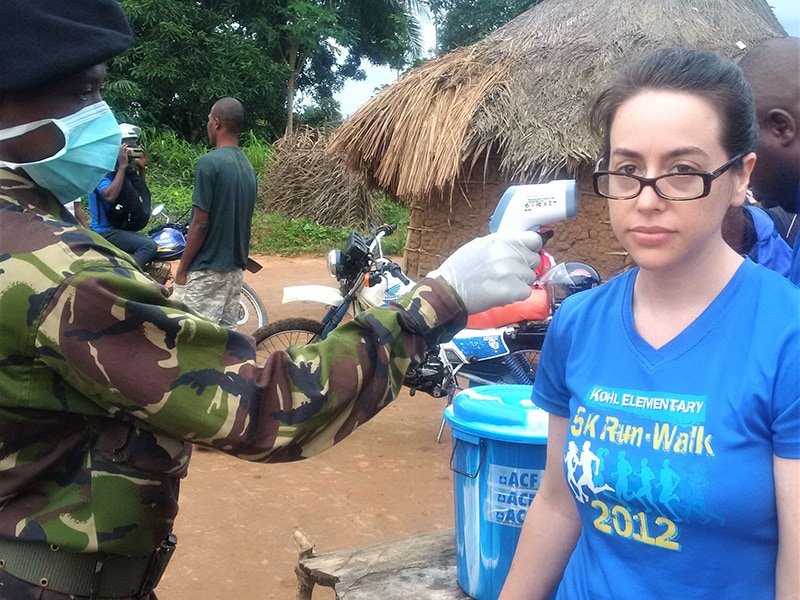Fighting Ebola on familiar ground

During West Africa’s 2014-2016 Ebola epidemic, Dana Schneider waits at a border health check point while the person behind her is screened.
In the fight against Ebola in the Democratic Republic of the Congo, Dana Schneider can rely on some familiar skills.
There’s her knowledge of French, which she studied since 7th grade. There’s her familiarity with Africa rooted in her stint as a Peace Corps volunteer. And there’s her experience with the last major Ebola outbreak in West Africa, which took her back to Guinea, the same country where she’d been with the Peace Corps.
Schneider, a CDC health scientist, recently returned from the DRC after a second deployment for the current Ebola outbreak response. During this latest deployment, she was working with the Surveillance Training to Enhance Ebola Response and Readiness (STEER) program, which bolstered key skills for thousands of healthcare workers in the DRC over the summer. Schneider helped draw up plans to monitor the results of the program, looking for signs that it’s helping turn the tide, and plan for ongoing mentorship for some of the participants.
“All of the trainings had to be done in a two and a half week period, which was very challenging,” she says.
Schneider grew up in Boulder, Colorado, and joined the Peace Corps after earning a bachelor’s degree in cell and molecular biology at Tulane University with a minor in French. Because of her language skills, the Peace Corps sent her to Guinea, a former French colony, to teach middle-school math.
However, “It was apparent that math was not the most pressing need in my village,” she says. “There were a lot of health issues that were quite obvious, and I didn’t have the tools I felt at the time to try to help on that front.”
The experience made Schneider decide to go into public health. She got an MSPH from Emory University and began working with CDC through a work-study program while in grad school. She joined the agency full-time in 2008 and currently works with other countries to strengthen disease detection and response capacities at and along borders to prevent the international importation or exportation of communicable diseases of public health concern.
“CDC deployers are putting a lot of hours and a lot of energy into the response and are really very dedicated,” she said. “They take it extremely seriously, and their desire to do good and have an impact is something I’ve noticed in all deployments I’ve been a part of.”
Early in the current DRC outbreak, she was part of a CDC team in Kinshasa, helping that country’s Health Ministry craft a strategy for tackling the disease at points of entry and along migration routes. In 2017, she deployed to Madagascar, where she helped that African island nation fight a plague epidemic. And in 2014, when the worst Ebola outbreak to date struck West Africa, the CDC dispatched her back to Guinea – twice.
On her first deployment, she helped Guinea’s government tighten health screening for travelers at the international airport in Conakry. The second time, she was working with her old outfit, the Peace Corps, on a program that used a cascading train-the-trainer model similar to STEER.
The American volunteers had left Guinea, but the local Peace Corps staffers were still reporting for work and wanted to do something to help their country combat Ebola. Most of the staff had no prior public health background. Schneider and others taught them the signs and symptoms of Ebola, what people should do if they’d been exposed or if they knew someone with the disease.
“Collectively, the staff spoke all the local Guinean languages,” she says. “Peace Corps had a good reputation and good relationships with communities, so these staff were able to get into communities that were difficult for CDC and other responders to access.”
This strategy delivered important Ebola prevention information to hard-to-reach communities and in ways that Guineans responded well to. This helped combat what she said were some of the fears surrounding the disease. Although STEER has a different target audience and focus, the use of a cascading train-the-trainer model to strengthen Ebola knowledge and skills among Congolese health workers may be able to give today’s response in the DRC a similar break, she says.
“There are some parallels, I think,” she says. “There probably needs to be more of that engagement to try to combat a lot of the misunderstandings and the distrust that seem to be so prevalent in this outbreak, as with Guinea and Sierra Leone and Liberia, too.”






















.png)











No hay comentarios:
Publicar un comentario